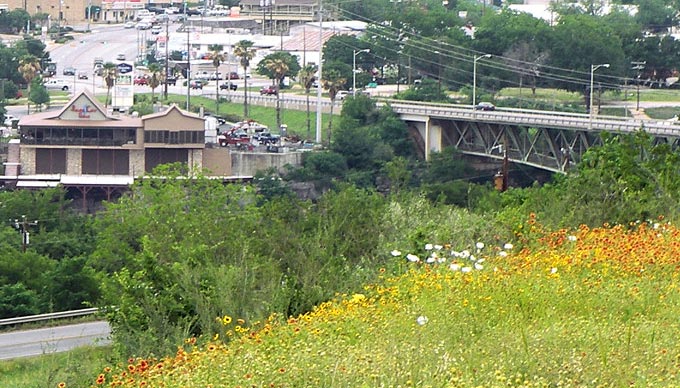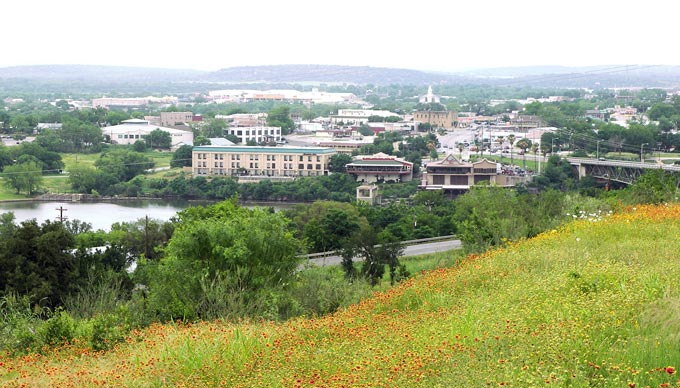By John Hallowell
Where are the Marble Falls? Behind the thriving modern city of Marble Falls, with its upscale shops, fine restaurants, hotels, galleries and music venues, there lurks a fascinating tale of a blind man’s remarkable vision and an industrial city that languished through the middle of the 20th century before blossoming as a commercial center during the last three decades.
Photo: Wikipedia
Marble Falls was founded in 1887 by Adam Rankin Johnson, a former Indian fighter and Confederate general who had dreamed, during his pre-war days as a Burnet County surveyor, of building an industrial city powered by the natural marble falls. Despite a “friendly fire” incident which blinded him near the end of the Civil War, General Johnson followed through with his dream, facilitating the construction of a railroad to nearby Granite Mountain in 1884, then (with ten partners, including one son, one nephew and two sons-in-law) platting the townsite and selling lots, beginning July 12, 1887. In 1889, the railroad was extended to Marble Falls. By 1890, there were about 500 residents in the new town, which boasted three general stores, two churches, a hotel, a cotton gin, a gristmill, a tannery, a shoe factory and a weekly newspaper.
Photo: Wikipedia
During the 1890s, a bridge was built across the Colorado River, a college was chartered (the old building will soon be the home of the “Falls on the Colorado Museum”) and a large factory was built near the falls. The town grew to a population of 1,800 within ten years. In 1906, a young druggist named E.G. Michel built a majestic three-story building — the largest drug store in Texas, with a fine opera house on the second floor — on Main Street in Marble Falls. The city made history in 1917 by electing Ophelia Crosby “Birdie” Harwood as the nation’s first woman mayor, three years before women were allowed to vote! Some of the streets were paved in the 1920s, and some street lights were installed. But General Johnson died in 1922, and the fabulous drug store/opera house burned down in 1927. A flood washed the bridge away in 1935, and even though it was quickly replaced, Marble Falls seemed to be in a slump through the middle of the 20th century. In 1940, the population was only 1,021.
Photo: Wikipedia
Growth resumed when the new Max Starcke Dam was completed in 1951, even though the marble falls which had given the town its name were submerged under the new Lake Marble Falls. While the town’s economy struggled through the drought of the 1950s, a new economy based on tourism and retirement began to grow. By the 1980s, Marble Falls had grown into the retail and entertainment center for the surrounding area, and the city continues to attract tourists, retirees and new businesses. By 2000, the population had reached 4,959, with 817 businesses. Today, Marble Falls is a major commercial and cultural center for the eastern Hill Country, providing goods, services and entertainment options for affluent communities all along the chain of Highland Lakes, as well as other nearby Hill Country towns. A satellite campus of Texas Tech University is located in Marble Falls, and a new regional medical center is currently under construction.
Photo: Wikipedia
Marble Falls maintains a busy schedule of events; the biggest events are LakeFest in August, when world-class drag boats come to race on Lake Marble Falls, and the famous Walkway of Lights, on the north side of the lake between Thanksgiving and New Year’s Day. For more details on events and attractions, visit http://www.marblefalls.org







